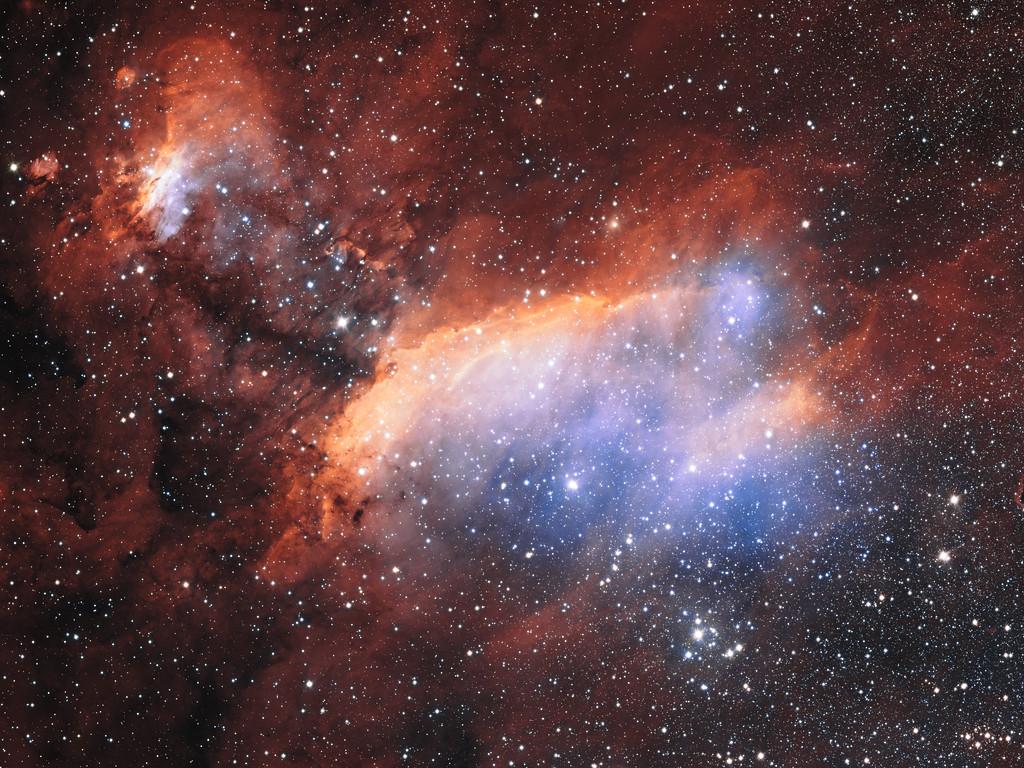Science
Related: About this forumYoung Stars Cooking in the Prawn Nebula

The glowing jumble of gas clouds visible in this new image make up a huge stellar nursery nicknamed the Prawn Nebula. Taken using the VLT Survey Telescope at ESO’s Paranal Observatory in Chile, this may well be the sharpest picture ever taken of this object. It shows clumps of hot new-born stars nestled in among the clouds that make up the nebula.
Located around 6000 light-years from Earth in the constellation of Scorpius (The Scorpion), the nebula formally known as IC 4628 is a huge region filled with gas and clumps of dark dust. These gas clouds are star-forming regions, producing brilliant hot young stars. In visible light, these stars appear as a blue-white colour, but they also emit intense radiation in other parts of the spectrum — most notably in the ultraviolet [1].
It is this ultraviolet light from the stars that causes the gas clouds to glow. This radiation strips electrons from hydrogen atoms, which then later recombine and release energy in the form of light. Each chemical element emits light at characteristic colours when this process occurs, and for hydrogen the predominant colour is red. IC 4628 is an example of an HII region [2].
The Prawn Nebula is around 250 light-years across, covering an area of sky equivalent to four times that of the full Moon. Despite this huge size it has been often overlooked by observers due to its faintness and because most of its light is emitted at wavelengths where the human eye is not sensitive. The nebula is also known as Gum 56, after the Australian astronomer Colin Gum, who published a catalogue of HII regions in 1955.
more
http://www.eso.org/public/news/eso1340/
CrispyQ
(36,460 posts)Stunning image. Love the red glowing 'eyes.'
Judi Lynn
(160,525 posts)Sharpest Ever Image Of Prawn Nebula Unveiled
September 18, 2013
Watch the Video: Zooming In On The Prawn Nebula
Lee Rannals for redOrbit.com – Your Universe Online
Astronomers using the Very Large Telescope (VLT) at the European Southern Observatory’s (ESO) Paranal Observatory in Chile have taken the sharpest image ever of the Prawn Nebula.
The stellar nursery, formally known as IC 4628, sits 6,000 light-years from Earth in the constellation of Scorpius. The new image shows clumps of hot new-born stars nestled among the clouds making up the nebula.
New stars born in these gas clouds emit intense radiation, most notably in the ultraviolet spectrum; in ultraviolet light — the same kind of radiation that causes unprotected human skin to burn when exposed to too much direct sunlight. The Earth’s atmosphere shields life on the surface from most ultraviolet radiation, yet longer wavelengths are able to reach the ground, which cause tanning and sunburns. The young, hot stars in IC 4628 are emitting such radiation.
“This radiation strips electrons from hydrogen atoms, which then later recombine and release energy in the form of light. Each chemical element emits light at characteristic colors when this process occurs, and for hydrogen the predominant color is red. IC 4628 is an example of an HII region,” ESO said in a statement.
More:
http://www.redorbit.com/news/space/1112951095/prawn-nebula-sharpest-ever-image-091813/